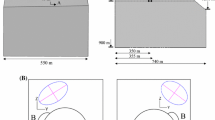Summary
An Underground Research Laboratory (URL) has been constructed by Atomic Energy of Canada Limited (AECL) to study various aspects of disposing of nuclear fuel waste in the Canadian Shield. In order to ensure good quality and long life of the construction, one important factor to be considered is the in situ stress field. As part of the research program, stress changes have been measured during the advance of a tunnel to monitor the stress response to excavation. It is desirable to estimate the state of in situ stress from these stress change measurements and to compare the results with overcoring data. This paper describes the application of a recently developed stress change fitting technique for stress determination. The basic principle and the fitting procedure are briefly summarized and the back-analysis process for the data collected at the URL is presented in detail. A boundary element model was used to predict the stress changes as required by the fitting approach. This new method of in situ stress determination was successfully applied in this case. The back-analyzed stresses agree very well with those determined from overcoring tests. The quality of individual measurements was assessed and the required minimum number of measurements for a conclusive data interpretation is evaluated.
Similar content being viewed by others
References
Crough, S. L., Starfield, A. M. (1983): Boundary Element Method in Solid Mechanics. George Allen & Unwin, London.
Lang, P. A., Kuzyk, G. W., Babulic, P. J., Bilinsky, D. M., Everitt, R. A., Spinney, M. H., Kozak, E. T., Davison, C. C. (in prep.): Room 209 Instrument Array: Measured Response to Excavation. Atomic Energy of Canada Ltd. Report AECL 9566-3.
Lang, P. A. (1989): Room 209 Excavation Response Test in the Underground Research Laboratory. NEA Workshop on Excavation Response in Geological Repositories Radioactive Waste, Winnipeg (1988), Canada. Published by Nuclear Energy Agency, OECD, Paris, 295–329.
Martin, C. D. (1989): Failure Observations and In Situ Stress Domains at the Underground Research Laboratory. Conference on Rock Mechanics and Rock Physics at Great Depth, Pau, France,2, 719–726.
Wiles, T. D., Curran, J. H. (1982): Use of the 3 D Displacement Discontinuity Element for Modelling. 4th International Conference on Numerical Methods in Geomechanics, Edmonton, Alberta, Canada.1, 103–109.
Zou, D., Kaiser, P. K. (1990): Determination of in situ Stresses from Excavation-induced Stress Changes. Rock Mech. and Rock Eng.23, 167–184.
Author information
Authors and Affiliations
Rights and permissions
About this article
Cite this article
Kaiser, P.K., Zou, D. & Lang, P.A. Stress determination by back-analysis of excavation-induced stress changes — a case study. Rock Mech Rock Engng 23, 185–200 (1990). https://doi.org/10.1007/BF01022953
Issue Date:
DOI: https://doi.org/10.1007/BF01022953




